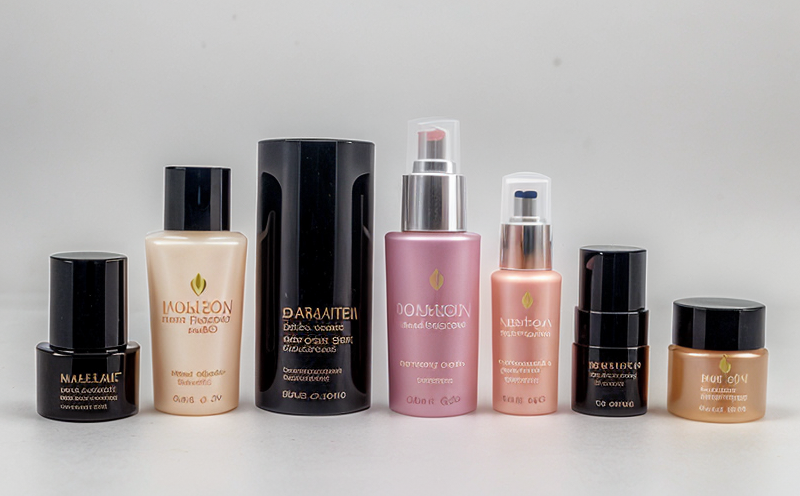Pump Mechanism Migration Testing in Cosmetic Sprays
In the world of cosmetics, ensuring product safety is paramount. One critical aspect of this responsibility lies in the evaluation of pump mechanisms within cosmetic sprays for potential migration of chemicals into the formula. This process, known as pump mechanism migration testing in cosmetic sprays, involves a series of stringent tests designed to identify any harmful substances that may migrate from the packaging or container into the cosmetic product itself.
Migration can occur due to a variety of factors including the nature of the materials used in the packaging, the chemical composition of the cosmetic formula, and environmental conditions such as temperature changes during storage. The primary goal is to ensure that no harmful substances exceed the prescribed limits set by regulatory bodies like the European Union's Cosmetic Regulation or the U.S. Food and Drug Administration (FDA).
The testing methodology typically involves filling a pump mechanism with the cosmetic product, sealing it for an extended period under controlled conditions, and then analyzing the contents of the container after a specified time frame. Instruments such as gas chromatography-mass spectrometry (GC-MS) are often used to detect and quantify any potentially harmful substances that may have migrated.
This service is particularly important in cosmetic products where direct contact between the packaging material and the product is inevitable, such as sprays, lotions, or shampoos. By conducting this test, manufacturers can ensure their products meet stringent quality standards and comply with international regulations, thereby protecting consumers from potential health risks.
It's worth noting that not all cosmetic products are subject to these tests; however, those containing ingredients like parabens, fragrances, or other preservatives are often prioritized for this type of analysis. The testing process is crucial in ensuring product safety and can significantly enhance consumer trust in the brand.
The regulatory landscape surrounding cosmetic products is continually evolving, with new standards being introduced to address emerging health concerns. By staying compliant with these regulations, manufacturers not only safeguard public health but also maintain a positive reputation among consumers.
Quality and Reliability Assurance
The quality assurance process in cosmetic testing is comprehensive, involving multiple stages to ensure the accuracy and reliability of results. This includes meticulous sample preparation, rigorous testing protocols, and thorough data analysis.
Sample preparation begins with selecting a representative sample from the batch being tested. The selected pump mechanism is then filled with the cosmetic product according to specified volumetric or weight-based criteria. The container is sealed under controlled conditions for an extended period, typically ranging from 24 hours to several weeks depending on the specific test requirements.
Upon completion of the holding period, the sample is analyzed using advanced analytical techniques such as gas chromatography-mass spectrometry (GC-MS) and inductively coupled plasma mass spectrometry (ICP-MS). These instruments are capable of detecting even trace amounts of potentially harmful substances. The results are then compared against established safety limits to determine compliance.
The reliability of the test is further enhanced by using internationally recognized standards such as ISO 21968:2017 and ASTM D5438-09e1, which provide clear guidelines for testing procedures. By adhering to these standards, laboratories ensure that their results are consistent and comparable with those from other reputable testing facilities.
Quality assurance also extends to the personnel involved in conducting these tests. Only qualified and certified technicians perform these analyses, ensuring that the process is conducted under strict quality control measures. Regular calibration of instruments and periodic audits further reinforce the reliability of the results.
Environmental and Sustainability Contributions
The focus on pump mechanism migration testing in cosmetic sprays not only enhances product safety but also contributes positively to environmental sustainability. By ensuring that no harmful substances migrate from packaging into the cosmetic formula, this service helps reduce the risk of environmental pollution.
When materials used in packaging are found to be safe for use with cosmetics, it encourages the development and adoption of sustainable packaging solutions. This includes using recycled or biodegradable materials where appropriate. The testing process also promotes responsible disposal practices by ensuring that only compliant products reach the market.
The regulatory landscape increasingly emphasizes sustainability, and compliance with these regulations can lead to reduced waste generation and lower environmental impact. By conducting this test, manufacturers not only meet legal requirements but also contribute to a more sustainable future.
In addition to enhancing product safety and promoting environmental sustainability, this service helps drive innovation in the cosmetic industry by encouraging the development of safer and more sustainable packaging materials. This can lead to new product formulations that are both safe for consumers and kinder to the environment.
Why Choose This Test
- Ensures product safety: By identifying any potential harmful substances that may migrate from the packaging into the cosmetic formula, this test helps ensure consumer safety.
- Avoids legal issues: Compliance with regulatory requirements can help avoid costly litigation and penalties associated with non-compliance.
- Enhances brand reputation: Demonstrating a commitment to product safety through rigorous testing can significantly enhance the brand's image in the market.
- Promotes trust: Consumers are increasingly concerned about the safety of the products they purchase. A proven track record of conducting such tests can build and maintain consumer trust.





